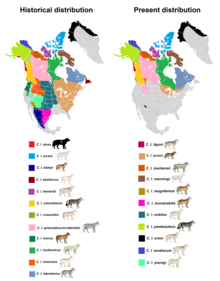Newfoundland wolf
| Newfoundland wolf | |
|---|---|
 | |
| Mounted specimen | |
| Scientific classification | |
| Domain: | Eukaryota |
| Kingdom: | Animalia |
| Phylum: | Chordata |
| Class: | Mammalia |
| Order: | Carnivora |
| Family: | Canidae |
| Genus: | Canis |
| Species: | |
| Subspecies: | †C. l. beothucus |
| Trinomial name | |
| †Canis lupus beothucus | |
 | |
| Historical and present range of gray wolf subspecies in North America | |
The Newfoundland wolf (Canis lupus beothucus) was a subspecies of grey wolf that was native to Newfoundland. As a food source, the species would prey and rely on the Newfoundland caribou. During the autumn and early winter, some wolves would turn white while others remained dark enough to look black.[citation needed]
Description[edit]
It was described as being a medium-sized,[2] slender-skulled wolf with a white pelt, though melanists also occurred. In comparison to its mainland relatives it bears a striking difference in its internal accessory cusp angles allowing for distinction between subspecies.[3] The last specimen was reportedly killed in 1911.[1]

Taxonomy[edit]
This wolf is recognized as a subspecies of Canis lupus in the taxonomic authority Mammal Species of the World (2005).[4] In 1912, Gerrit S. Miller Jr have concluded that in North America, specifically west of the Mississippi River and Hudson Bay, and north of the Platte and Columbia rivers, there are three types of wolves: timber-wolf, plains-wolf, and tundra-wolf.[5]
Recent sightings[edit]
In 2019 a wolf was shot in Newfoundland after being confused for a coyote.[6] DNA evidence found it, and a second wolf found on Newfoundland to be a Labrador wolf, which are often seen in neighbouring Labrador but rare on Newfoundland.[7]
See also[edit]
References[edit]
- ^ a b Allen, Glover M (1942). "Newfoundland wolf". Extinct and vanishing mammals of the western hemisphere with the marine species of all the oceans. American Committee for International Wild Life Protection. pp. 205–206. OCLC 602905667.
- ^ Mech, L. David (1981). The Wolf: The Ecology and Behavior of an Endangered Species. University of Minnesota Press. p. 352. ISBN 978-0-8166-1026-6.
- ^ Allen, Glover M.; Barbour, Thomas (May 1937). "The Newfoundland Wolf". Journal of Mammalogy. 18 (2): 229. doi:10.2307/1374474. JSTOR 1374474.
- ^ Wozencraft, W. C. (2005). "Order Carnivora". In Wilson, D. E.; Reeder, D. M. (eds.). Mammal Species of the World: A Taxonomic and Geographic Reference (3rd ed.). Johns Hopkins University Press. pp. 575–577. ISBN 978-0-8018-8221-0. OCLC 62265494. beothucus, p. 576, at Google Books
- ^ Allen, Glover M.; Barbour, Thomas (1937). "The Newfoundland Wolf". Journal of Mammalogy. 18 (2): 229–234. doi:10.2307/1374474. JSTOR 1374474.
- ^ "The Newfoundland Wolf is Back". Whale House. 4 February 2019.[self-published source?]
- ^ "DNA samples prove 2nd wolf in Newfoundland". CBC News. 23 August 2012.
Further reading[edit]
- Bergerud, Arthur T. (1971). "The Population Dynamics of Newfoundland Caribou". Wildlife Monographs (25): 3–55. JSTOR 3830370.
- Bergerud, Arthur Thompson (1969). The population dynamics of Newfoundland caribou (Thesis). doi:10.14288/1.0104108. hdl:2429/35483.


 French
French Deutsch
Deutsch